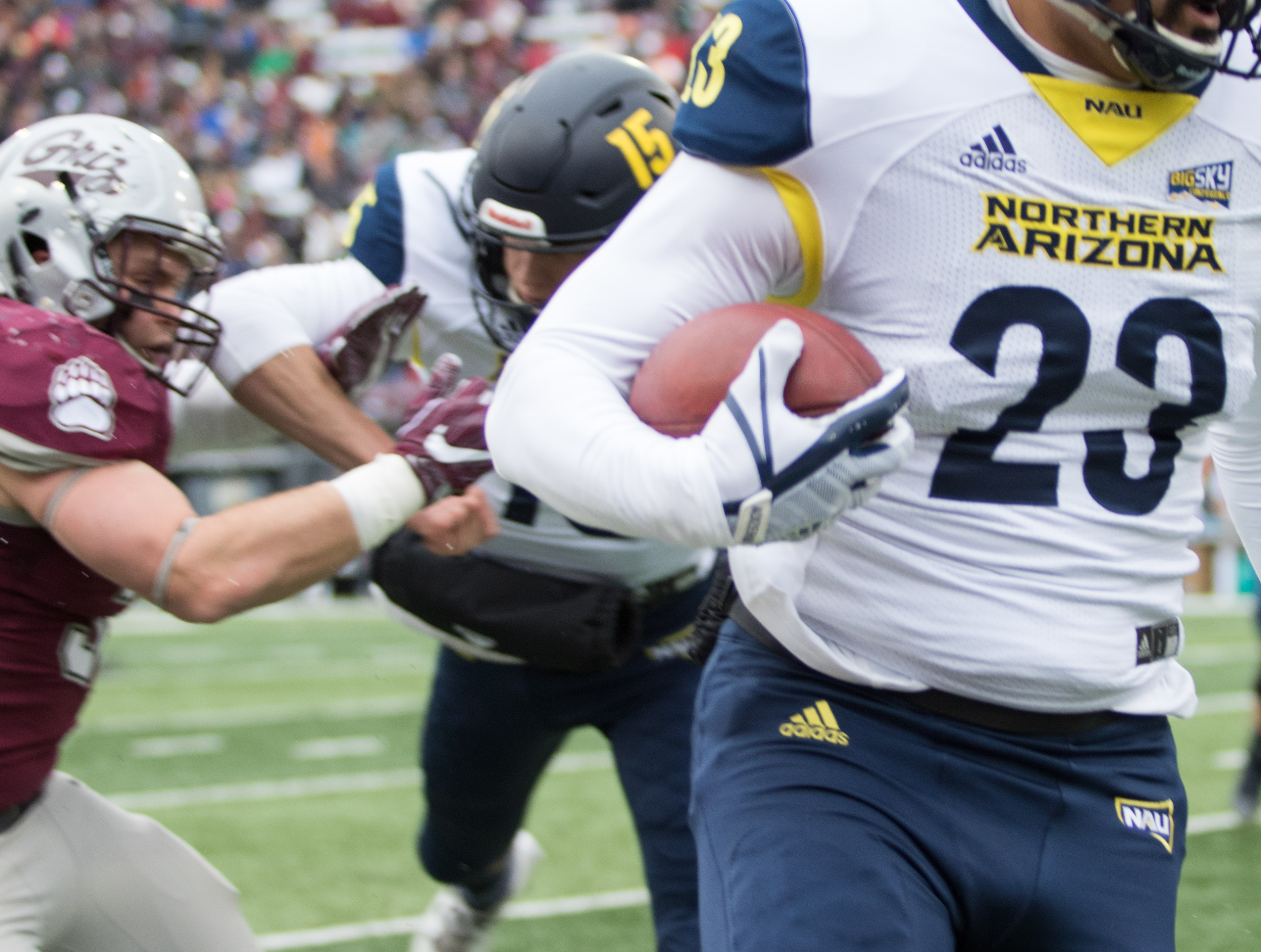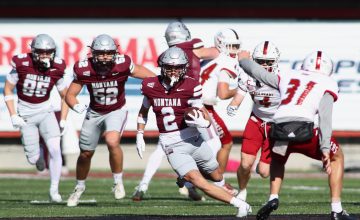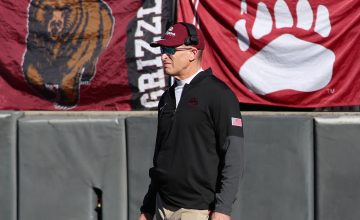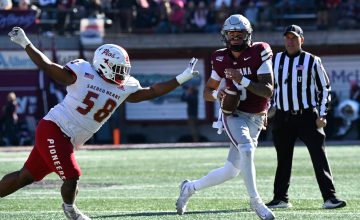Over the last month, both Montana State and Montana have been involved in football games that have seen pivotal offensive players thrown out of football games for a rule originally created to mediate the violence of defenders.
Three weeks ago in MSU’s first trip to Greely, Colorado since 2013, Bobcat senior starting running back Nick LaSane fumbled against Northern Colorado. The play was blown dead but the officials did not emphasize the whistle enough as UNC defensive back Henry Stelzner picked up the loose ball. LaSane hustled to chase him down before launching himself at the Bear ball carrier.
LaSane struck Stelzner with the crown of his helmet, garnering a flag for targeting. He was promptly ejected, an unorthodox disqualification made even stranger when the officials ruled LaSane was down, helping MSU maintain possession.
Last Saturday in Missoula on the first play of Northern Arizona’s second offensive possession, NAU ran a wide receiver reverse. All-American sophomore quarterback Case Cookus peeled back to set a block for Wallace Gonzalez. Cookus leveled Montana senior linebacker James Banks with a vicious crack-back block.
He too was called for targeting, leading to an ejection that played an influential part in Montana’s 17-15 win over the No. 9 team in the FCS.

Montana senior Connor Strahm thanking NAU QB Case Cookus (15) for the hit which lead to his ejection/by Jason Bacaj
“I don’t think I’ve ever seen a quarterback get a targeting foul,” NAU 20th-year head coach Jerome Souers said following the game. “If you would’ve told me that was going to happen, I would’ve said that’s right out of a nightmare. Case is a very tenacious competitor but you don’t ever want to see a player do anything that would reflect poor play.
“I think he really meant to clear the way and create a play for his teammates. That was a tough play.”
The ejection is the third involving the Griz in the last two weeks alone. In the first half of Montana’s 41-27 loss at Weber State, senior defensive end Korey Alexander and senior defensive end Tucker Schye were both ejected from the game for targeting calls.
Weber State linebacker Cardon Malan, North Dakota safety Chuck Flowers, Idaho State defensive tackle JonRyheem Peoples, Cal Poly safety B.J. Nard and Portland State linebacker Braxton Winterton are among the other Big Sky players who have been ejected this season for targeting.
“You hate to see a young man lose an opportunity to compete in a game,” Montana State head coach Jeff Choate said on Monday. “We had it happen to us a couple of weeks ago. I didn’t really argue the call, just the way the thing went down in terms of the mechanics of the play. I’ve seen the play that involved Case last week in Missoula. You make the argument that hey, it might be the right call. But Tom Brady is probably not getting kicked out of the game there. On a micro level, we are talking about the same thing. Those are tough calls.”
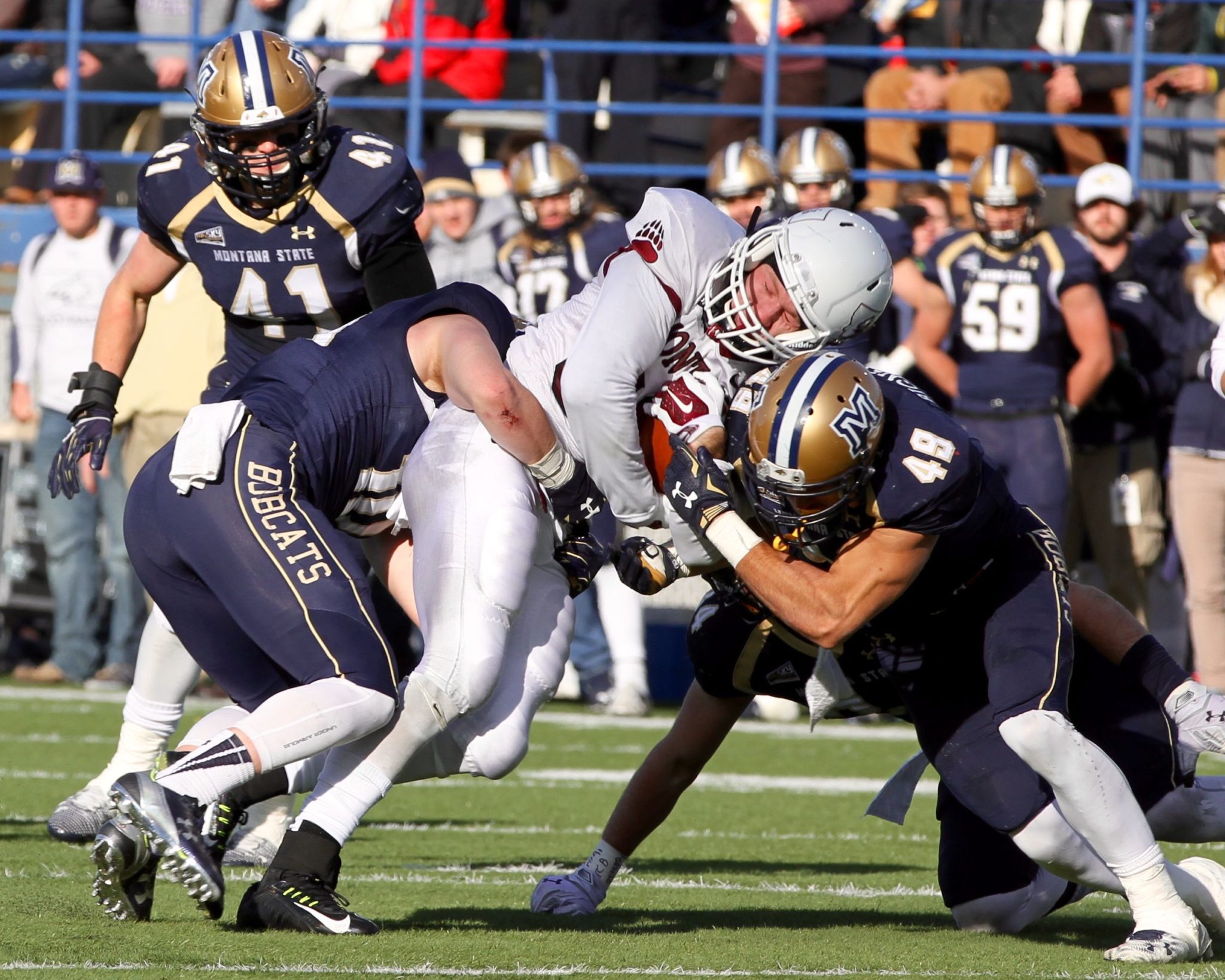
Montana wide receiver Josh Horner and Montana State linebacker Mac Bignell meet head up with a group of ‘Cat defenders in 2015/by Brooks Nuanez
Choate went on to credit officials for making “bang-bang” calls and for the implementation of replay two years ago so “hopefully we get the call right.” Although the in-game call is often up to interpretation of the observing official, the premise of the rule in general is key to the preservation of football, Choate said.
“We have to be smart,” Choate said. “We have to be smart around the quarterback. We have to be smart around the sideline and we have to take the head out of the game for the preservation of the game.
“There’s some growing pains here. But eventually, we will get through this phase and everyone will understand this is the way the game needs to be played to preserve it and maintain the integrity of the game. While we can all have an opinion and we are all entitled to an opinion with what’s the right call, what’s the wrong call, we are working through it right now both as coaches, as players and as officials.”
The NCAA installed the targeting rule in 2008 in hopes of removing forcible hits to the head or neck. But the application of the rule during games, especially when an automatic ejection was added in 2013, has been controversial.
The NCAA rulebook defines targeting as:
- Making “forcible contact against an opponent with the helmet crown,” or the top of the tackler’s head.
- Making “forcible contact to the head or neck area of a defenseless opponent.”
For a play to be targeting, it also has to have at least one “indicator”:
- Launching, or “leaving his feet to attack an opponent by an upward and forward thrust of the body to make forcible contact in the head or neck area”
- A crouch and upward thrust to make head or neck contact, even if the hitter still has feet on the ground
- Leading with the “helmet, shoulder, forearm, fist, hand or elbow to attack with forcible contact at the head or neck area”
- “Lowering the head before attacking by initiating forcible contact with the crown of the helmet”
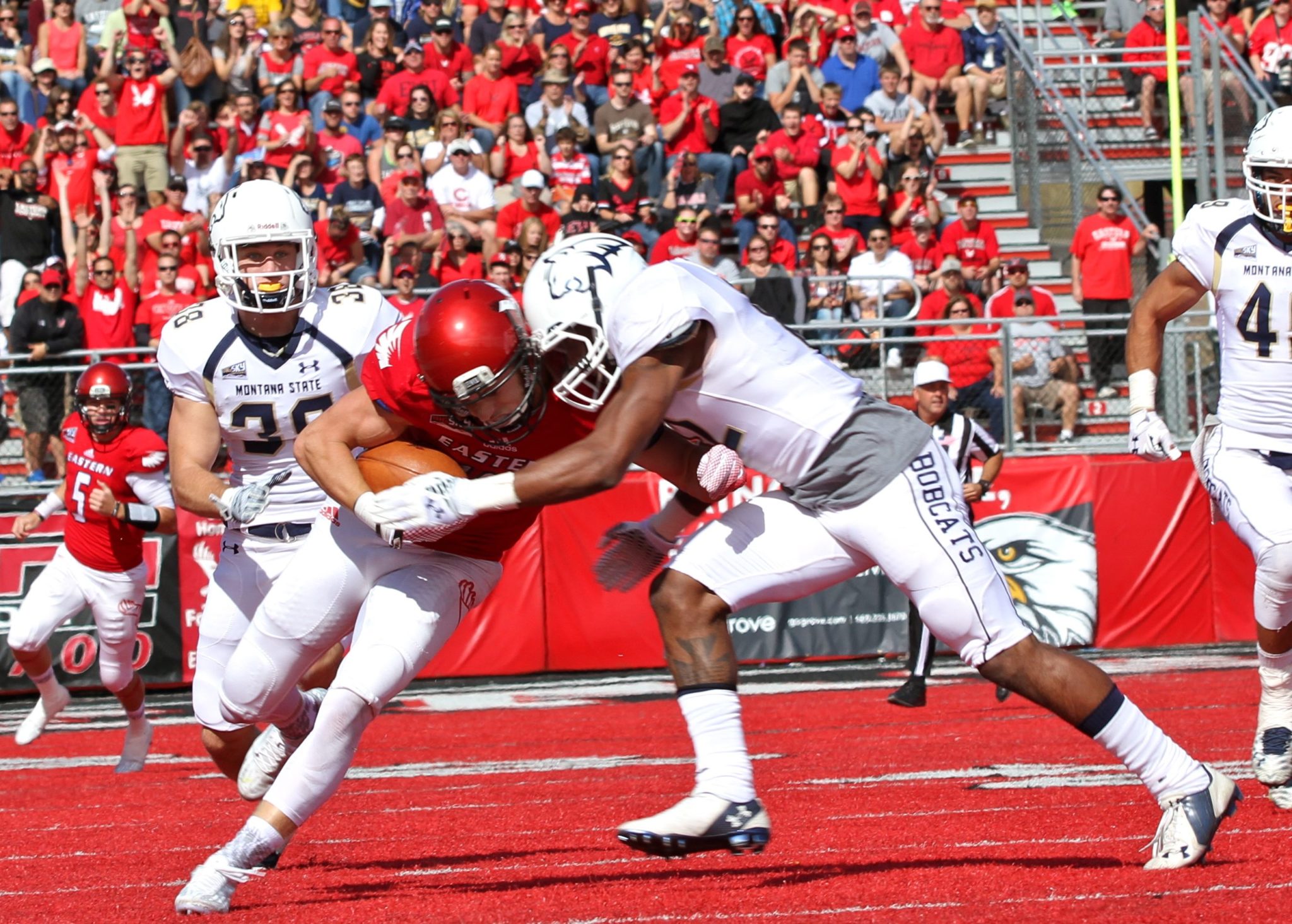
Montana State safety Khari Garcia (12) hits former Eastern Washington wide receiver Cooper Kupp (10) in 2015/by Brooks Nuanez
“I’ve been thinking about it a lot and here’s how I look at it: what makes it hard for coaches and players is when things are maybe interpreted a little bit differently week to week based on the (referee) crew, based on the situation, what the emphasis is,” Choate said. “It’s kind of one of those rules, even though it’s not the first year the rule has been here, it’s one of those rules that is still evolving. It’s going to take some time to standardize it. It’s a good rule.
“We have tried to coach out some of those shots that can be devastating,” Choate said. “We’ve been victim to a couple who haven’t gotten called. It’s not that they don’t want to call them, just sometimes they don’t see them. It’s especially hard on kicking plays. That’s where a lot of the most violent hits occur. It’s really difficult sometimes to see that because you are trying to watch for holding or you are trying to watch for a block in the back and you might not see that block on the backside or even on the sniper shot on the front side.
“There’s a variety of things that happen. Officiating is not an easy thing to do. It’s a challenging job. Just like we miss calls as coaches, they miss calls from time to time. We have to work together as a football community to increase the consistency of how those rules are interpreted and work with the officials and our players to try to take those sort of hits out of the game.”
Montana senior linebacker Connor Strahm has carved out a reputation as one of the hardest hitting players in the Big Sky Conference. He has claimed Montana’s “Golden Helmet” award given to the team’s hardest hitter each of the last two seasons and might be in line to claim the award again following his final year.
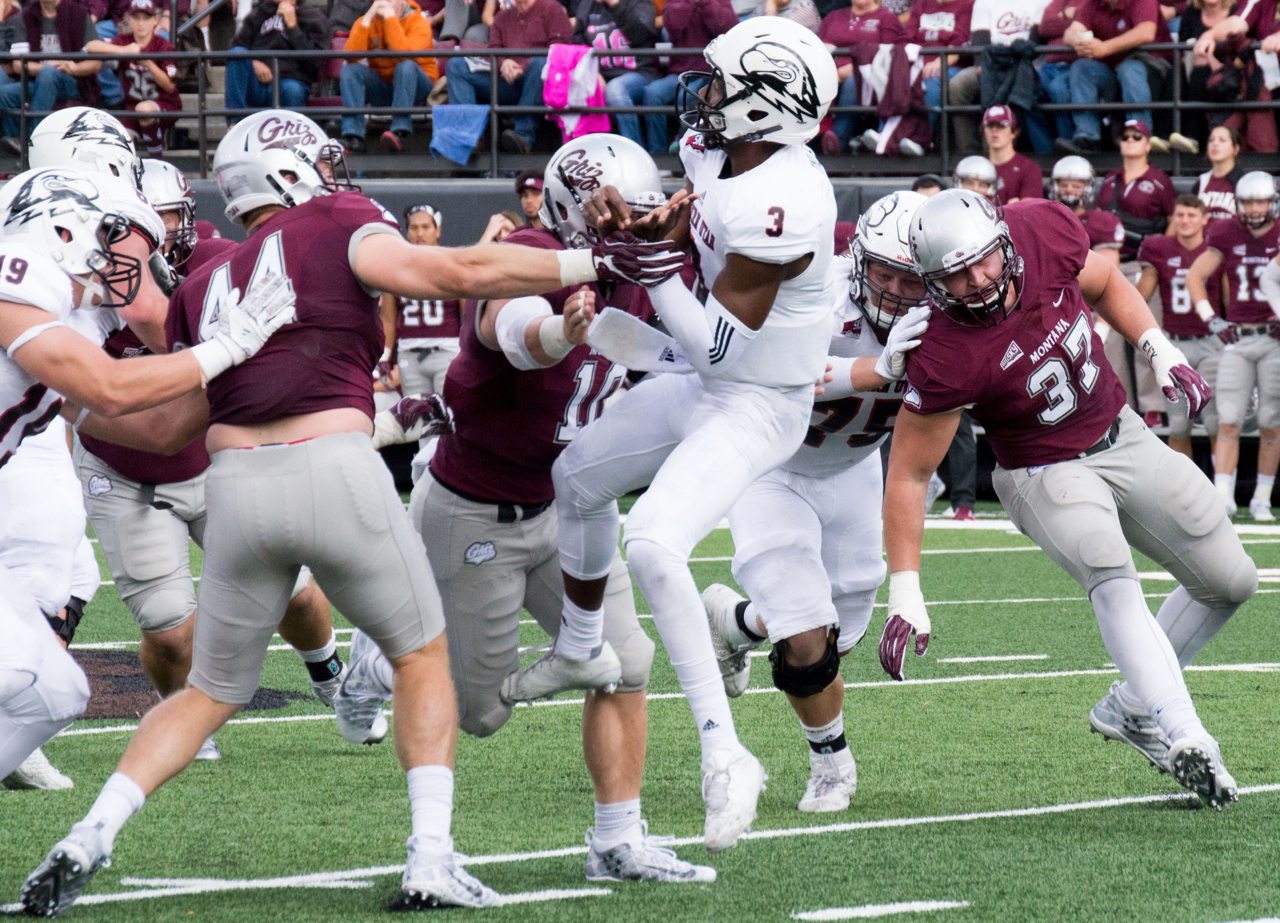
Montana linebacker Connor Strahm (10) hits Southern Utah quarterback Patrick Tyler (3) in 2016/by Jason Bacaj
The reigning Big Sky Conference Defensive Player of the Week said Monday that the targeting rule is always in the back of his mind.
“You never know with the refs so I didn’t know what they were thinking,’ Strahm said.
“You think about it but you don’t want to slow down. You have to be smart. You have to know when to hit him, where to hit him and what to hit him with.”
At the FBS level, targeting has been ripe as well. Several Pac 12 coaches have chimed in on the issue. Washington State head coach Mike Leach said the rule is “micromanaging, for lack of a better word,” on the Pac 12 coaches’ teleconference a few weeks ago. On that same call. Stanford head coach David Shaw said he believes there should be different levels of targeting penalties depending on how violent and severe the hit is.
“If the offensive player lowers his helmet, hey, great, put the onus on the defensive player and let’s have the 15-yard penalty,” Shaw said. “But let’s leave him in the game because it’s obvious that he’s trying not to hit the guy in the helmet, it just happened incidentally.”
UM third-year head coach Bob Stitt has been on both sides of ejections in the span of just two weeks. He understands the rule fully and agrees with Choate in the necessity of trying to maintain safety in the game.
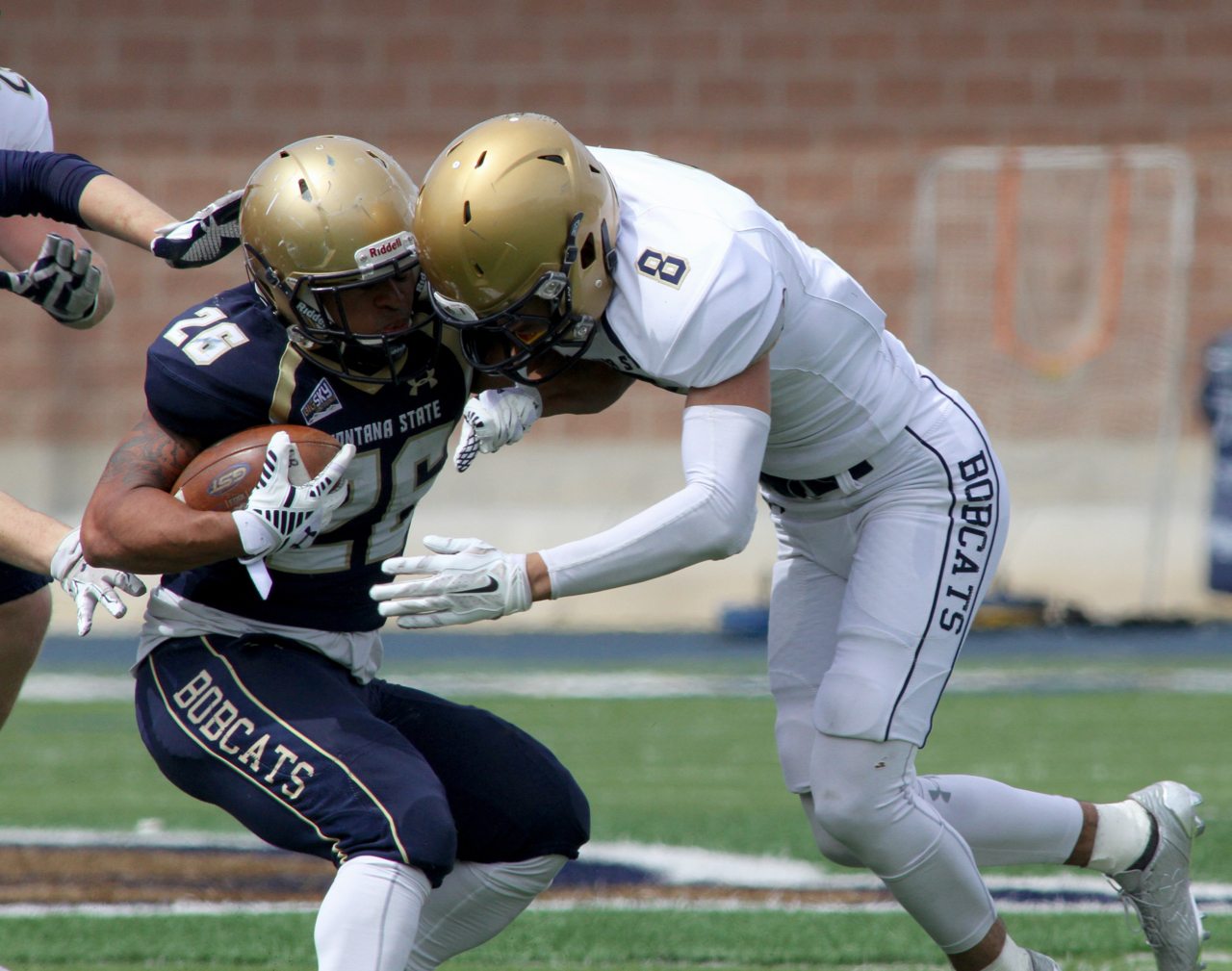
Montana State running back Anthony Peagues (26) hit by former cornerback Chris Harris (8) in 2016/by Brooks Nuanez
“Because of the rule, the kids are thinking about it,” Stitt said. “We have a great game and we don’t want it to go away. It can’t keep going the way it is. We have to make it safer. It’s going to have to change a little bit. I know the old-school people don’t like it at all.
“In these times with all the lawsuits and all the brain injuries, we have to try to make it safer and we can’t use our heads and our helmets as a weapon. I don’t want any of my players using their heads as a weapon. I don’t ever want to go through anything where one of our guys get injured. I think the rule is good. You just have to be smart about it.”
Photo attribution noted. All Rights Reserved.

